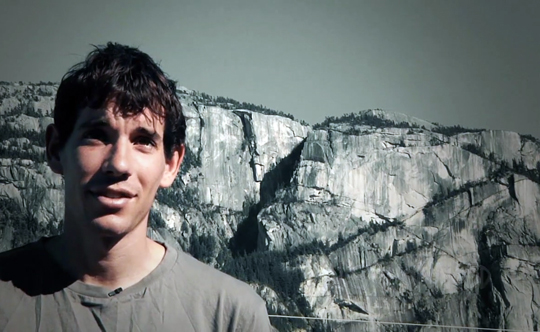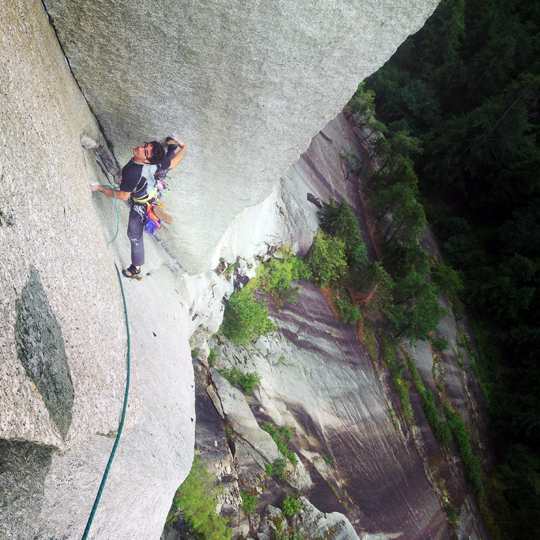
Alex Honnold climbed El Sendero Luminoso, in El Potrero Chico, this February with an entire photography and film crew in tow. The morning of the free solo ascent, he fielded their questions, and on the upper pitches of the route a separate team operated a camera-mounted drone that flew above his head. Last week, he ditched the media–as well as climbing partners, a rack of protection and a rope–to make the first free solo ascent of the University Wall on Squamish’s Chief. As far as he could tell, the only lens pointed in his direction was his friend James Lucas’s, who took a quick snapshot from the parking lot on Highway 99. If you squint, you can see a tiny Alex Honnold about as big as the million other pixels in the photo.
Today, the “U Wall” is a moderate (C2) and popular aid route generally climbed hammerless to the Dance Platform ledge in seven or eight long pitches. But for an intrepid crew of four, Tim Auger, Hamish Mutch, Dan Tate and Glenn Woodsworth, the 1965-1966 first ascent required, as Woodsworth put it in the 1970 Canadian Alpine Journal, “unabashed siege tactics,” and several phases in between Auger’s school exams. On the wall, Woodsworth remembers, they wondered “whether future climbers [would] view the present Age of Aid as a pathological result of man’s increasing alienation from other people and his increasing fascination with his machines.” But, he told Vancouver local Tami Knight during her research for the Squamish Mountain Profile (Alpinist 43), “The climb was partly a coming of age…. [It] showed that local climbers could climb big walls in good (for the day) style. [With only a total of nine or 10 bolts] it showed that there were other fine, natural lines on the big walls at Squamish.”
Sixteen years later, the only thing Peter Croft saw when he looked up at the Chief from the Tastee-Freez in town was that 1966 line. He ate soft-serve cones and imagined climbing the route free. “Nobody had tried. And yet it was so clearly the next step, with nothing else on our horizon to match it,” he wrote in Issue 43. He “split the terror” between Greg Foweraker and Hamish Fraser, and together they climbed it at 5.12a in July 1982.
Overcoming the cruxy first few pitches, he wrote, “felt like the curving uphill side of the globe. We took stock of ourselves: veins the size of garter snakes bulged from our forearms; various cuticle splits and hand gobies streaked bloodstains along our tanned forearms and onto our sweaty T-shirts. We looked as though we’d been battered in chalk. Even the whirls in our tangled hair were powdered white. But far more important than the trashed knuckles and fresh meat were the wide-eyed grins of elated shock at the monster we were creating.”
After a couple weeks the trio made a final push from the ground, free climbing to the Dance Platform where they walked off the wall along Bellygood Ledge. Urged by “the biggest buts of [their] young lives,” Croft and Fraser returned to free the entire route, without fixed ropes, through The Roman Chimneys to the truer summit.
This August 25, Honnold hiked from the parking lot along Highway 99, passing a small gaggle of climbers below the popular 5.10 finger crack Seasoned in the Sun and James Lucas on his way back down from his own clambering on University Wall, to arrive at the left side of the Chief’s massive Grand Wall and the base of his objective. He started climbing, thankful to be wearing a t-shirt to protect his skin from the chimneys and offwidths on the lower pitches. Reaching past Bellygood Ledge, he continued up The Roman Chimneys for its extra four pitches of 5.10 and 5.11 to top out. Like Croft and Fraser, Honnold says he never feels like he’s summited the Chief until he exits through those chimneys. By the time he was back at his car again, only two hours had passed.
This week, we paused to chat with Honnold about his University Wall solo, but ended up talking about much more.
In Peter Croft’s essay about freeing the University Wall, he writes: “I craved an odyssey that required my all–and quite possibly more…. I wanted to dive in and draw blood, and it was OK if that blood was my own.” Have you ever felt that way about climbing? If so, how often do you get that urge to do something really big like that?
I definitely feel the same way. I mean, that’s part of the appeal of big solo adventures. Just doing something that requires a bit more out of you.
Other than seeking out that kind of “odyssey,” why else did the U Wall first interest you? What finally gave you the opportunity to climb it now?
I climbed the U Wall on my first trip to Squamish something like eight years ago. It’s always represented that burly crack climbing style to me. It’s like the hardman version of Astroman. I’d wanted to solo it [during] other seasons in Squamish, but it’s often wet so I’d never had the opportunity. This year I had good conditions and actually felt up to it.

A climber’s understanding of a route can really be shaped by where the pitches begin and end. During your free solo, you were not confined to those parameters. How did that make your experience different from someone else’s (aside from the obvious endurance factor)?
This is a great question! One of the great things about soloing is the fact that you can flow through many pitches at a time without stopping. In the case of the U Wall I basically did it in two blocks. The first four pitches, then I took off my shoes at a tree belay, then I went to the top of the wall. It’s a very different feel than stopping arbitrarily every hundred feet or less.
What was the most interesting section of your free-flowing ascent and why?
One of the best parts for me was the crux of the second pitch, a sloppy and insecure undercling traverse that I’d always thought would be the scariest part. I knew how I planned to do it, but when I got there I felt so tight and strong under the roof that I wound up almost skipping the crux. I didn’t even have to do the moves I expected to, I just sort of brute-strengthed my way across, and it was over before I knew it. It was a pleasant surprise for me.
What did you think about as you climbed, other than the moves in front of you, which I imagine make up the bulk of your consciousness during a solo?
The upcoming moves definitely make up the bulk of my consciousness during a big solo, though in this case on the U Wall I was also somewhat aware of how well I was climbing. For whatever reason I just felt really good the whole time, and I knew that I was feeling good. It was a weird thing, but it was nice.
Did you did you climb the U Wall as a roped team before you made your solo? If so, with whom? And what did you learn about the route that you didn’t already know from the ground or from other climbers’ beta?
I’d climbed the U Wall many times before over my four different summers in Squamish. This season alone, I climbed it three times with three different friends. Cedar [Wright] and I climbed it in the rain on a day that would otherwise have been too wet to climb. (The U Wall shelters itself a bit.) Ultimately, climbing the route ahead of time wasn’t the most important part though. I hadn’t been up on it in two and a half weeks, but for whatever reason it just felt like it was time. I knew I would be ok, and I just went up there and climbed it. I guess the main thing was that in all the times I’ve climbed the U Wall I’ve never fallen off it, despite leading with a pack, linking pitches, climbing in the rain, etcetera, etcetera. I just had to go up and trust myself to climb as well as I always had before.

What do you think most knowledgeable climbers don’t know about long free solos like this one? What assumptions do they make?
I don’t know. I think that many people assume that there are no rests and that it’s a do or die proposition. And it’s true that it’s very continuous climbing, on the U Wall in particular, but there are stems and small edges and little places to rest all over. Soloing changes the perspective–instead of climbing nonstop to the anchor and then resting there, you just rest anywhere there’s a decent stance.
This question’s also not about U Wall specifically, but I’m still curious. Your ability and willpower to do these really long, hard free solos is eons ahead of anyone else right now, in 2014. Do you ever wish there were other climbers soloing at your level–people who could really truly relate to what you’re doing and share the psych? In other words, is it lonely at the top?
Again, this is a great question. I don’t know if I’m really ahead of anyone else, since Alex Huber has soloed 14a and Hansjoerg Auer has soloed long hard stuff like this, but I do sometimes wish there were more people playing the game. Sharing the psych is an important thing in climbing, which I think is why boulderers run in posses. It helps to have other people pushing you. And, not that I would want to be pushed very hard in soloing since it should be a conservative pursuit, but it’s always nice to find inspiration in others.